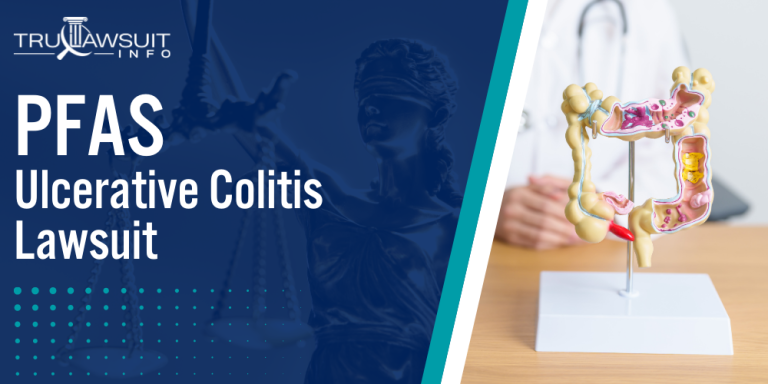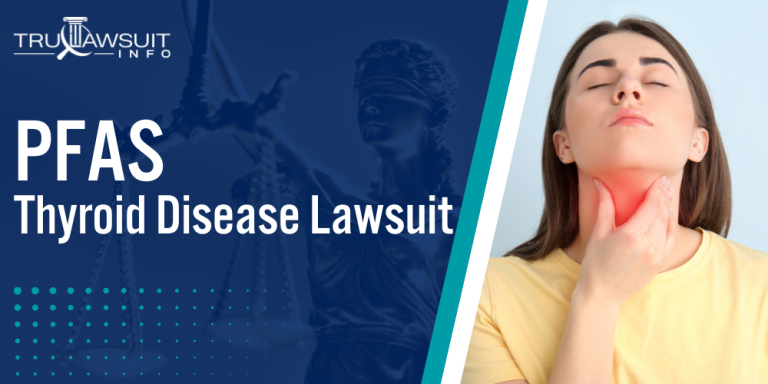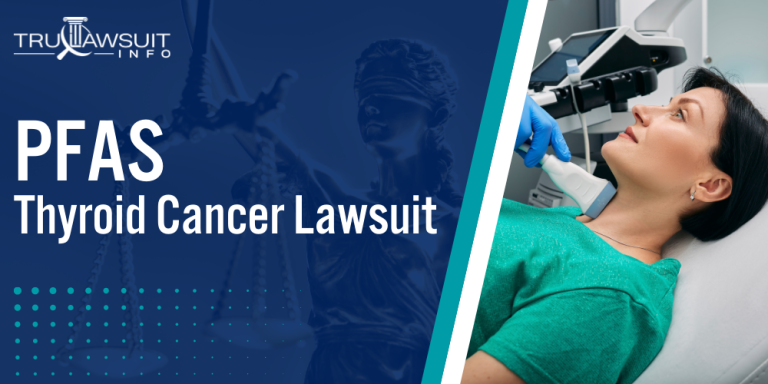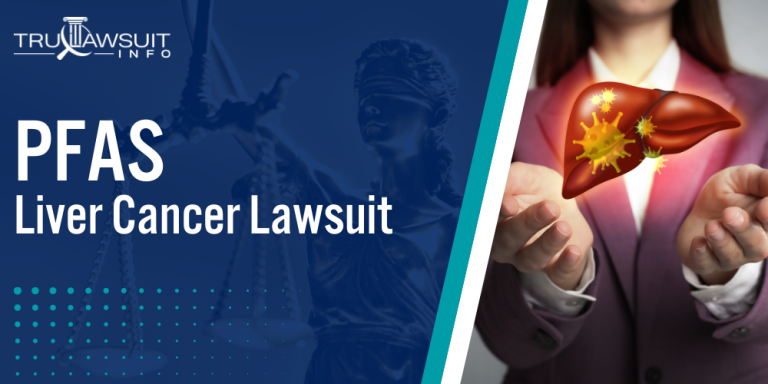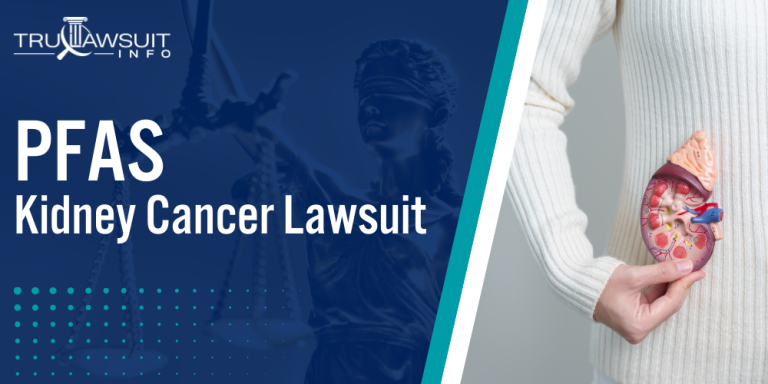Case Studies of Major PCB Cleanup Efforts
Key Takeaways:
- Remediation efforts are ongoing to address the persistent nature of PCB contamination.
- Regulations govern the proper cleanup and disposal of PCBs to protect human health.
- Various techniques are implemented strategically for effective PCB cleanup.
Overview of PCB Cleanup Case Studies
On this page, we’ll discuss an overview of major PCB cleanup case studies, the effectiveness of various PCB cleanup technologies employed, lessons learned from these large-scale PCB remediation efforts, and much more.
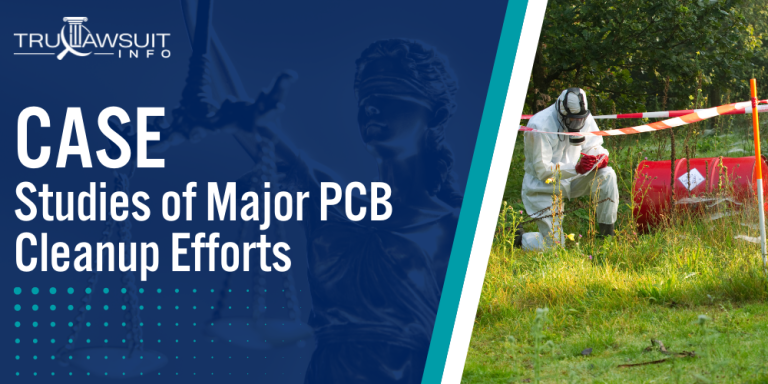
Intro To PCB Cleanup Case Studies
Studying major PCB cleanup projects provides valuable insights into the challenges, strategies, and outcomes of these complex endeavors.
Here are some notable case studies of PCB cleanup efforts:
- Hudson River PCB Cleanup: One of the largest and most complex Superfund sites in the U.S., involving dredging and disposal of PCB-contaminated sediments.
- New Bedford Harbor PCB Cleanup: Multi-phase project addressing extensive PCB contamination in the harbor sediments and surrounding areas.
- Kalamazoo River PCB Cleanup: This is a long-term effort to remove and contain PCBs from the river sediments, floodplains, and paper mill properties.
- Fox River PCB Cleanup: Multi-year project involving dredging, capping, and monitoring of PCB-contaminated sediments in the Lower Fox River.
If you or a loved one has experienced adverse health conditions after being exposed to PCB chemicals, you may qualify to pursue compensation.
Contact TruLawsuit Info using the chat on this page to receive an instant case evaluation to determine if you qualify to file a PCB lawsuit today.
Table of Contents
PCB Chemical Production History
In the span of the 20th century, polychlorinated biphenyls (PCBs) became widespread across numerous industrial applications, lauded for their chemical stability and insulating properties.
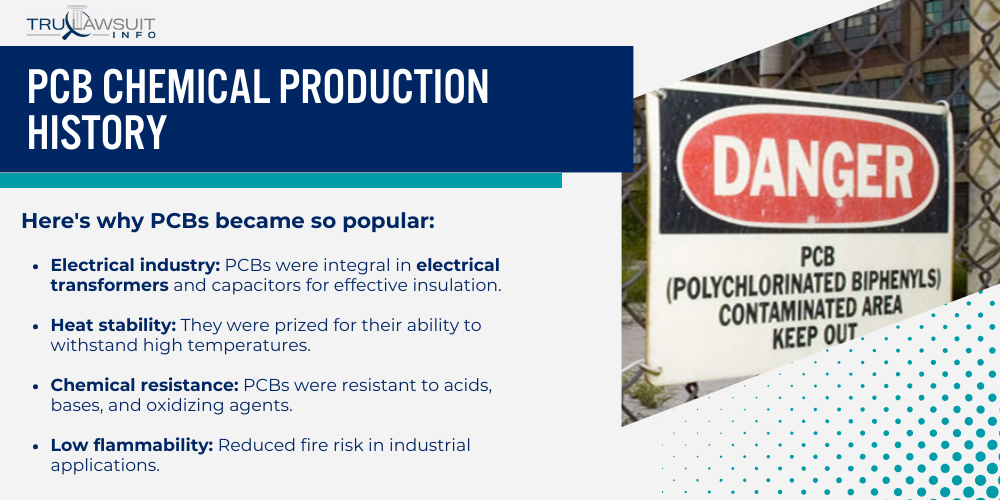
This section overviews PCBs’ emergence and Monsanto’s manufacturing dominance.
The Rise of PCBs: Discovery and Mass Use
Polychlorinated biphenyls (PCBs) were first synthesized in the late 19th century, with their unique properties quickly earning recognition.
By the early 20th century, PCBs had been widely used due to their chemical stability and excellent electrical insulating capabilities.
Here’s why PCBs became so popular:
- Electrical industry: PCBs were integral in electrical transformers and capacitors for effective insulation.
- Heat stability: They were prized for their ability to withstand high temperatures.
- Chemical resistance: PCBs were resistant to acids, bases, and oxidizing agents.
- Low flammability: Reduced fire risk in industrial applications.
The boom in PCB production reflected a growing demand across various sectors that required durable and reliable chemical solutions.
Monsanto and the PCB Manufacturing Monopoly
Monsanto Company, established in the early 1900s, quickly became the principal manufacturer of PCBs.
They maintained a virtual manufacturing monopoly from the 1930s until production ceased.
Monsanto’s Dominance in PCB Manufacturing:
- Starting point: Monsanto’s production began in the United States, extending globally over time.
- Market control: For several decades, Monsanto was the sole supplier of PCBs.
- Range of products: They catered to a broad market, from electrical transformers to hydraulic systems.
- Environmental concerns: The persistent nature of PCBs eventually led to environmental scrutiny.
Their central role in PCB production only waned after troubling evidence of PCBs’ environmental and health effects surfaced, leading to regulatory action and the cessation of manufacturing.
Health Risks of PCB Cleanup
The remediation of PCBs carries inherent health risks, particularly through exposure that could adversely affect human health and the surrounding environment.
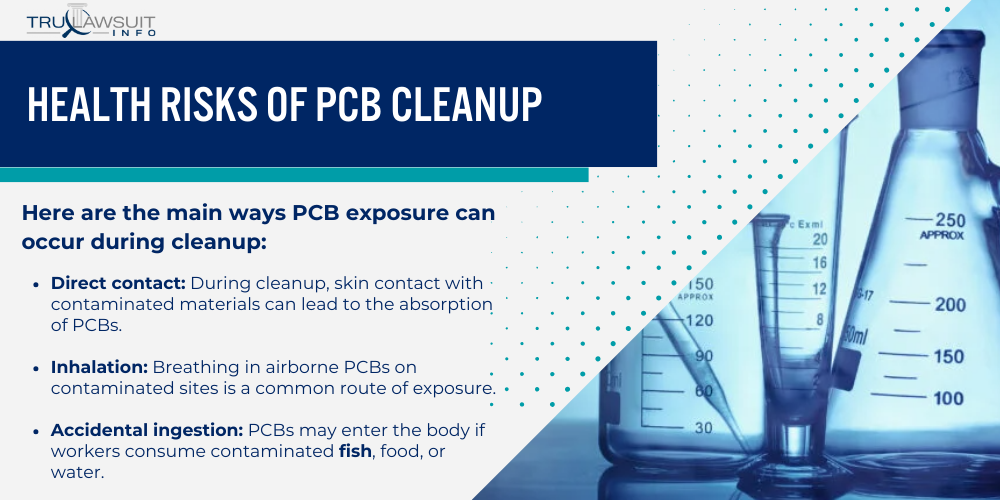
Human Health Hazards from PCB Exposure
Polychlorinated biphenyls (PCBs) are industrial chemicals that pose significant health risks when humans are exposed during cleanup activities.
Exposure primarily affects the nervous system and can lead to an increased risk of developing cancer.
Here are the main ways PCB exposure can occur during cleanup:
- Direct contact: During cleanup, skin contact with contaminated materials can lead to the absorption of PCBs.
- Inhalation: Breathing in airborne PCBs on contaminated sites is a common route of exposure.
- Accidental ingestion: PCBs may enter the body if workers consume contaminated fish, food, or water.
- Cross-contamination: There is a risk of spreading PCBs to other areas if proper decontamination procedures are not followed.
The Environmental Toll of PCB Contamination
Environmental Protection Agency (EPA) guidelines emphasize the importance of controlling PCB levels to minimize environmental impact.
PCBs can accumulate in the food chain, posing risks to wildlife and humans alike.
PCB contamination can have a devastating impact on various environmental aspects:
- Aquatic ecosystems: PCBs released into waterways can be absorbed by marine organisms, climbing the food chain.
- Soil degradation: PCB contamination in soil can affect plant health and biodiversity.
- Endangered wildlife: Species near the top of the food chain are particularly vulnerable to high PCB concentrations.
- Long-term persistence: Due to their stable chemical structure, PCBs can remain in the environment for decades, complicating remediation efforts.
PCB Cleanup: Regulations and Phaseout
Polychlorinated biphenyls (PCBs) are environmental pollutants, and stringent regulations govern their cleanup.
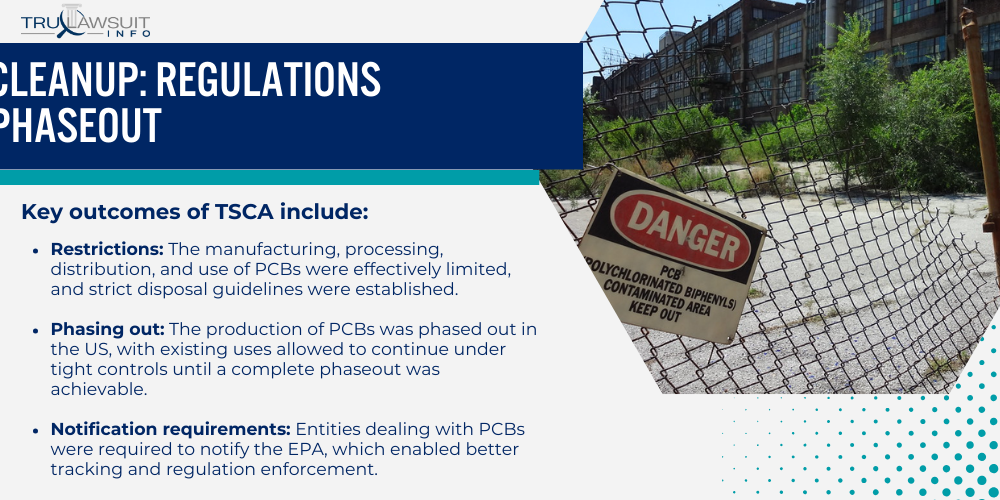
The phaseout of PCBs has been a critical effort to mitigate their long-lasting impacts on the environment and health.
1976 Toxic Substances Control Act’s Impact on PCBs
The 1976 Toxic Substances Control Act (TSCA) marked a significant turning point in the regulation of PCBs in the United States.
This legislation gave the Environmental Protection Agency (EPA) the authority to regulate the use and disposal of PCBs strictly.
Key outcomes of TSCA include:
- Restrictions: The manufacturing, processing, distribution, and use of PCBs were effectively limited, and strict disposal guidelines were established.
- Phasing out: The production of PCBs was phased out in the US, with existing uses allowed to continue under tight controls until a complete phaseout was achievable.
- Notification requirements: Entities dealing with PCBs were required to notify the EPA, which enabled better tracking and regulation enforcement.
- Operator responsibility: Entities managing PCB waste were mandated to follow specific cleanup methodologies, known as selected remedies, to ensure the protection of human health and the environment.
Worldwide Ban on PCB Production and Use
While the TSCA was a cornerstone in the United States, global efforts also emerged to address the PCB problem.
The Stockholm Convention on Persistent Organic Pollutants is a prime example.
This international treaty, which included a ban on the production and use of PCBs, pushed for a global cleanup initiative.
Critical points to note:
- Global consensus: The treaty received wide-ranging agreement from participating nations, highlighting the universal concern over PCBs.
- Targeted elimination: The objective is to eliminate PCBs by a set target date, with specific environmental guidelines for member countries.
- Cooperative efforts: International cooperation was emphasized to assist countries in achieving the established toxic substances control goals.
- Monitoring: Continuous assessment and monitoring by the international community are in place to ensure commitments are being met.
The cleanup and management of PCBs remain under close watch by the EPA and its international counterparts.
The unified goal is to decrease and eventually eliminate the risks associated with PCBs through firm regulatory actions and cooperative global efforts.
Environmental Legacy of PCB Contamination
The long-standing issue of PCB contamination has left a mark on environments worldwide, affecting not just soil and sediment but also water systems and the broader food chain.
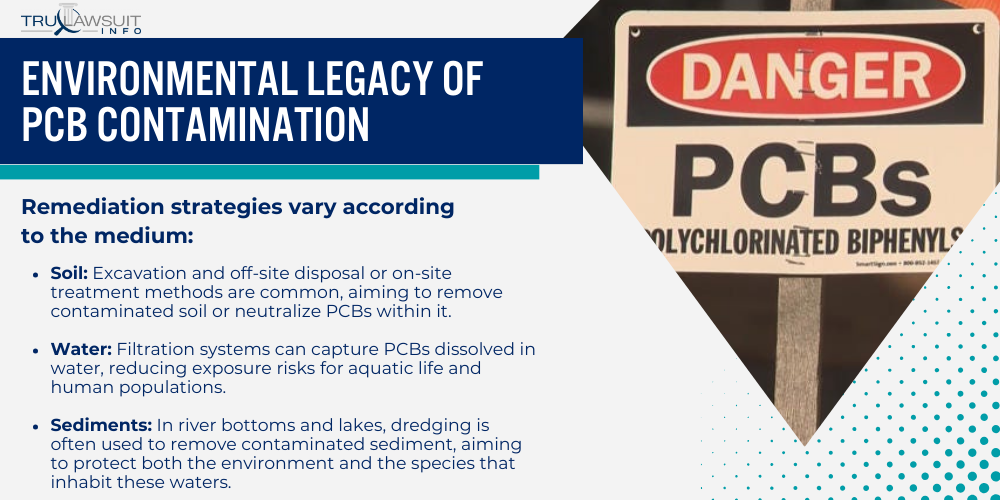
PCB Cleanup Practices in Soil, Water, and Sediments
Polychlorinated biphenyls (PCBs), once widely used in manufacturing and industry, have become prevalent environmental pollutants.
Cleanup has been a focused effort, especially in contaminated sites like Superfund sites, where PCBs pose significant environmental and health risks.
Remediation strategies vary according to the medium:
- Soil: Excavation and off-site disposal or on-site treatment methods are common, aiming to remove contaminated soil or neutralize PCBs within it.
- Water: Filtration systems can capture PCBs dissolved in water, reducing exposure risks for aquatic life and human populations.
- Sediments: In river bottoms and lakes, dredging is often used to remove contaminated sediment, aiming to protect both the environment and the species that inhabit these waters.
- River bottom: Sediment removal has been undertaken to lessen the long-term impacts on river ecosystems known to harbor PCB hotspots.
The Chain of PCB Bioaccumulation
PCBs bioaccumulated in wildlife can lead to elevated, harmful levels of PCBs higher up in the food chain, including in humans.
PCBs are particularly insidious for their ability to accumulate in tissues over time:
- Food chain: Once PCBs enter the food chain, they can end up in the foods consumed by humans, leading to potential health concerns.
- Contaminated sediment: Acts as reservoirs for PCBs, which then enter the food chain through bottom-dwelling organisms.
- PCB contaminated sediments: Continuously release PCBs into the environment, making total removal or containment necessary for a long-term solution.
- River ecosystems Face disruptive effects throughout the entire food web due to the persistence of PCBs in sediments.
PCB Cleanup Techniques and Remediation Strategies
Effective PCB cleanup strategies are essential for environmental health.
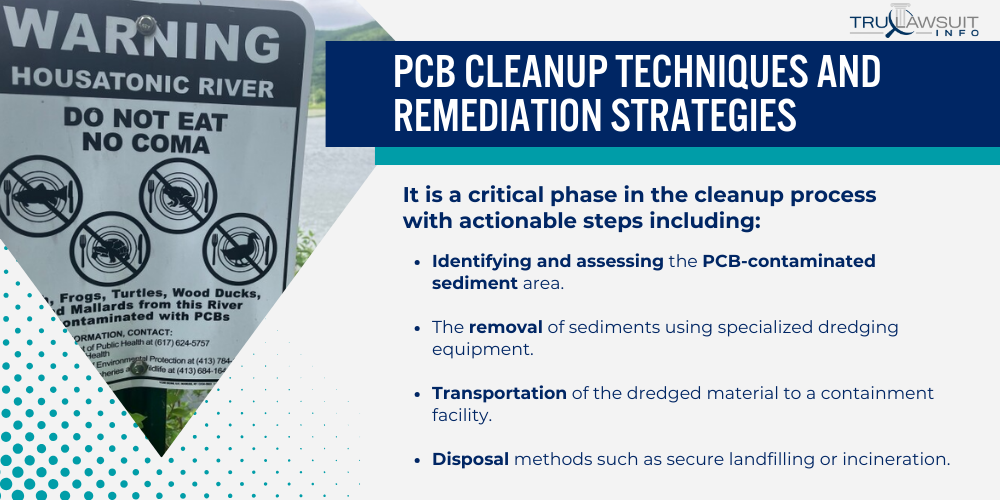
The techniques for remediation and disposal of polychlorinated biphenyls (PCBs) have evolved to ensure safety and efficiency.
PCB Sediment Dredging and Safe Disposal
Dredging is a common method used to remove PCB-contaminated sediments from water bodies.
It is a critical phase in the cleanup process with actionable steps including:
- Identifying and assessing the PCB-contaminated sediment area.
- The removal of sediments using specialized dredging equipment.
- Transportation of the dredged material to a containment facility.
- Disposal methods such as secure landfilling or incineration.
Proper dredging can reduce the spread of PCBs and minimize ecological damage.
For instance, the EPA outlines specific regulations for PCB waste management, including options for disposal according to PCB concentration levels.
Advancements in PCB Bioremediation and Chemical Treatments
Bioremediation and chemical treatments represent innovative strategies in breaking down PCBs in soils and sediments.
Advances in these areas include:
- Microbial degradation: The use of bacteria that can metabolically break down PCBs into less harmful compounds.
- Phytoremediation: Utilizing plants known for their ability to absorb, concentrate, and metabolize PCBs.
- Chemical methods: Application of chemicals to dechlorinate or otherwise neutralize PCBs.
- Thermal desorption: Heating soil to release PCBs, then capturing them for treatment.
These techniques focus on transforming or destroying PCBs, often making them a preferred option for remedial action.
EPA’s fact sheet highlights best practices for greener cleanup efforts, indicating a trend towards more sustainable and less invasive chemical treatments.
Challenges in Ongoing PCB Cleanup Management
Efforts to manage and reduce the impact of Polychlorinated Biphenyls (PCBs) continue to face multiple obstacles, from identifying contamination sources to replacing these hazardous substances in industrial applications.
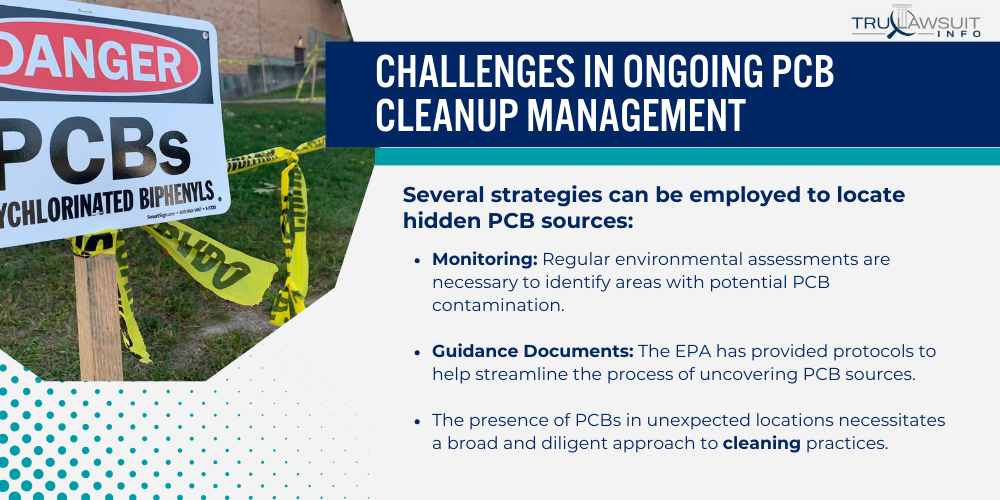
Uncovering Hidden PCB Sources
Finding the origins of PCB contamination remains a difficult task.
Often, PCBs lie dormant in the environment, in PCB hotspots such as aged industrial sites or in materials like old electrical equipment and building materials.
Several strategies can be employed to locate hidden PCB sources:
- Monitoring: Regular environmental assessments are necessary to identify areas with potential PCB contamination.
- Guidance Documents: The EPA has provided protocols to help streamline the process of uncovering PCB sources.
- The presence of PCBs in unexpected locations necessitates a broad and diligent approach to cleaning practices.
- Advanced technologies, such as drone surveillance, can aid in the detection of these hidden sources.
Innovating Non-PCB Alternatives for Industrial Use
The transition away from PCBs to safer alternatives in industrial processes involves extensive research and development.
The driving forces behind the development of non-PCB alternatives are multifold:
- Regulations have prompted industries to seek out non-PCB materials for use in products like transformers and capacitors.
- Replacing PCBs in plastics and other materials is an ongoing effort to prevent further environmental contamination.
- Development of guidance for using alternatives needs to keep pace with technological advancements.
- Industry-wide cleanups hinge on finding effective replacements that do not compromise efficiency or safety.
Corporate Accountability in PCB Cleanup
Corporate accountability plays a significant role in the remediation of areas affected by polychlorinated biphenyls (PCBs).
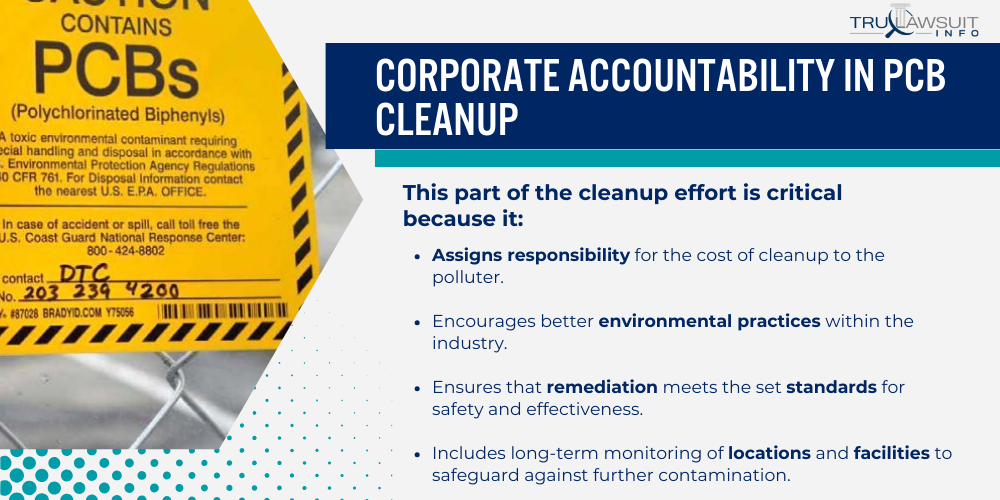
Firms that operated facilities where PCBs were used or disposed of must adhere to EPA regulations for cleaning up these hazardous contaminants.
Corporate Liability in PCB Contamination Cleanup
Corporate liability ensures that companies are held responsible for the environmental damage they cause.
This part of the cleanup effort is critical because it:
- Assigns responsibility for the cost of cleanup to the polluter.
- Encourages better environmental practices within the industry.
- Ensures that remediation meets the set standards for safety and effectiveness.
- Includes long-term monitoring of locations and facilities to safeguard against further contamination.
Responsibility also extends beyond the immediate cleanup, involving the monitoring and reporting of the affected conditions to the authorities.
The Influence of Corporates on PCB Regulations
The interaction between corporations and regulatory bodies can shape the policies surrounding PCB cleanup.
Companies have a dual influence on this process:
- Through compliance, corporations indirectly set the benchmark for remediation outcomes.
- They may lobby for regulations that balance environmental responsibility with business realities.
- Their experiences with PCB remediation can provide practical insights for updating guidelines.
- Collaboration with the EPA can lead to innovative approaches to managing PCB waste and pcb cleanup locations processes.
Their involvement ensures the creation of practices that are not only protective of the environment but are also attainable and economically viable for the business community.
Insights from the PCB Era
During the years when PCBs (polychlorinated biphenyls) were widely used, significant lessons were learned about the management and regulation of hazardous substances.
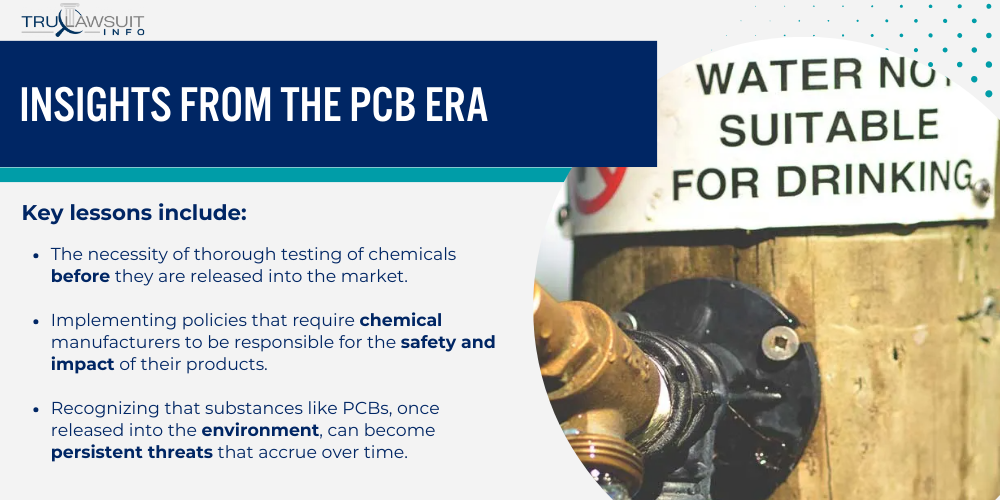
The insights gained from that era continue to shape environmental policies and practices today.
Emphasizing the Precautionary Principle in Chemical Use
The extensive use of PCBs until their ban in the United States in 1979, due to their toxicity and persistence, highlights the importance of the precautionary principle in chemical manufacturing and usage.
This principle suggests that if an action or policy has a suspected risk of causing harm to the public or the environment, in the absence of scientific consensus, the burden of proof that it is not harmful falls on those taking the action.
Key lessons include:
- The necessity of thorough testing of chemicals before they are released into the market.
- Implementing policies that require chemical manufacturers to be responsible for the safety and impact of their products.
- Recognizing that substances like PCBs, once released into the environment, can become persistent threats that accrue over time.
- Ensuring that regulatory agencies have adequate power to monitor and manage any potential contaminants.
Advocating for Greater Industry Transparency and Responsibility
The issue with PCBs also exposed the need for more transparency and responsibility from industries that manufacture or use potentially harmful substances.
This insight underscored the importance of regulatory agencies in holding companies accountable and the benefits of public access to information.
Concrete actions learned are:
- Industries must fully disclose potential hazards associated with their chemicals.
- Continuous monitoring is essential to avert and manage contamination scenarios.
- Adequate labeling and information should be given about the safe handling and disposal of chemicals.
- Companies should be held accountable for environmental clean-up when their actions result in contamination.
Through lessons drawn from the PCB era, environmental protection has become more proactive, highlighting the critical importance of foresight and caution in chemical management to safeguard both human health and the ecosystem.
TruLawsuit Info: #1 PCB Cleanup Lawyer
When dealing with polychlorinated biphenyls (PCBs) contamination, legal expertise in environmental law is vital.
A reputable PCB cleanup lawyer represents those affected by contamination at various sites.
In Washington, given the intricate nature of environmental statutes, a skilled attorney who specializes in relevant local and federal laws is indispensable.
Key Services Offered:
- Investigation of contamination sources.
- Evaluation of remediation and cleanup strategies.
- Legal representation for individuals and communities exposed to PCBs.
- Secure compensation for damages related to PCB exposure.
Significant Cleanup Efforts involve:
- Remediating affected waterways and land areas.
- Implementing long-term monitoring at the impacted locations.
- Seeking justice for those exposed to harmful levels of PCBs.
- Working closely with environmental agencies to ensure comprehensive cleanup.
The role of a #1 PCB Cleanup Lawyer might be pivotal for clients seeking resolute action against polluters.
They leverage a robust understanding of environmental law to support clients throughout the legal process.
Their goal is to ensure that responsible parties are held accountable for their actions that lead to environmental harm.
Locations that have seen the involvement of such lawyers extend to places with documented cases of PCB contamination, where communities may have been unknowingly exposed to dangerous chemicals.
They often collaborate with state and federal agencies to facilitate cleanup and advocate for the health and safety of local residents.
Frequently Asked Questions
-
What are the approved procedures for PCB remediation?
The Environmental Protection Agency (EPA) has outlined specific methods for the remediation of PCBs.
These procedures include chemical destruction, thermal destruction, and approved landfill disposal.
Each method must adhere to stringent EPA guidelines to ensure safe handling and reduction of PCBs in the environment.
-
What are the EPA's current regulations on PCB cleanup?
The EPA’s regulations on PCB cleanup are detailed in Title 40 of the Code of Federal Regulations (CFR).
The regulations cover various aspects, including cleanup standards, recordkeeping, reporting requirements, and disposal methods for PCB waste.
-
How has PCB cleanup evolved since 2021?
Since 2021, advancements in PCB cleanup have focused on improving efficiency and minimizing environmental impact.
Innovative approaches, such as green remediation practices and the development of less toxic disposal methods, have been increasingly emphasized.
-
How should PCB remediation waste be properly handled and defined?
PCB remediation waste includes items like contaminated soil, sediments, and building materials.
The EPA defines and recommends handling procedures for such waste, ensuring it is contained, transported, and disposed of in a manner that prevents further environmental contamination.
-
What policies govern the cleanup of PCB spills?
PCB spill cleanup is governed by policies such as the PCB Spill Cleanup Policy, which mandates quick spill containment and cleaning, proper disposal of PCBs, and procedures for decontaminating affected materials.
-
What steps can be taken to minimize PCBs in the environment?
To minimize PCBs in the environment, steps include regular monitoring of PCB-prone areas, implementing best practices for industrial handling, increasing public awareness, and improving technologies for detection and degradation of PCBs.
These actions are essential to maintain a healthy ecosystem and reduce potential human health risks associated with PCB exposure.

Experienced Attorney & Legal SaaS CEO
With over 25 years of legal experience, Jessie is an Illinois lawyer, a CPA, and a mother of three. She spent the first decade of her career working as an international tax attorney at Deloitte.
In 2009, Jessie co-founded her own law firm with her husband – which has scaled to over 30 employees since its conception.
In 2016, Jessie founded TruLaw, which allows her to collaborate with attorneys and legal experts across the United States on a daily basis. This hypervaluable network of experts is what enables her to share reliable legal information with her readers!
Have A Case?
Here, at Tru Lawsuit Info, we’re committed to helping victims get the justice they deserve.
To do this, we actively work to connect them with attorneys who are experts in litigating cases similar to theirs.
Would you like our help?
Tru Lawsuit Info is a reliable source of information about issues that may affect your health and safety, such as faulty products, data breaches, and environmental hazards.
Our team of experienced writers collaborates with medical professionals, lawyers, and advocates to produce informative articles, guides, and other resources that raise awareness of these topics.
Our thorough research provides consumers with access to reliable information and updates on lawsuits happening around the country. We also can connect consumers with attorneys if they need assistance.
Camp Lejeune's water contamination issue spanned several decades starting in the 1950s. Exposure to these chemicals has been linked to various serious health issues, including cancer, organ diseases, and death.
Research is increasingly suggesting a link between the use of Tylenol during pregnancy and the development of neurodevelopmental disorders, such as autism and ADHD, in infants.
Legal action is being taken against manufacturers of Aqueous Film-Forming Foam (AFFF), a chemical used in fighting fires. The plaintiffs allege that exposure to the foam caused health issues such as cancer, organ damage, and birth and fertility issues.
Have A Case?
Here, at Tru Lawsuit Info, we’re committed to helping victims get the justice they deserve.
To do this, we actively work to connect them with attorneys who are experts in litigating cases similar to theirs.
Would you like our help?

